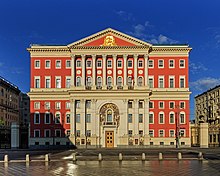Tverskaya Street
The Tverskaya Street ( Russian Тверская улица / Tverskaya Ulitsa to German "Tver street") is a central street in Moscow , Russia . It begins in the immediate vicinity of the Kremlin and leads about two kilometers in a north-westerly direction to the Garden Ring , where it turns into First Tverskaya Jamskaya Street . This in turn is about one kilometer long and is equal to the Belarusian railway station in the Leningrad prospectus on which the beginning of the highway M10 from Moscow to Saint Petersburg is.
history
Tverskaya Street emerged from an old trade route that connected the Tsar's seat, Moscow, with the city of Tver , at that time an important principality capital. The first houses were built along the way in the 14th century, followed by shops and handicraft businesses. With the expansion of Moscow, the role of the street grew; it moved increasingly towards the city center and was also inhabited by boyars and other wealthy people. In the 17th century the road was paved and widened. Since then, it has been regarded as the gateway to the city, which was also used by many guests coming from outside the city. Since the tsars often passed Tverskaya on their travels, the street was nicknamed Tsar's Street .
After the construction of Saint Petersburg at the beginning of the 18th century and the relocation of the Russian capital there, the road originally leading to Tver was also extended to Petersburg. Tverskaya Street thus became the starting point of the most important Russian traffic route, which further increased its role in the life of the city. More and more mansions and luxurious palaces were built along the Tverskaya. In 1784 the Governor General's Palace was built here, which has since served as the seat of the Moscow City Fathers and is still populated by the Moscow City Council today. At the beginning of the 20th century, Tverskaya was not only the most prestigious address in the city, but also its busiest shopping and business street.
A few years after the October Revolution , Tverskaya Street was radically redesigned as part of the extensive renovation work in Moscow, which became the capital of the Soviet Union . In 1932 it was renamed together with First Tverskaya Jamskaya Street in Gorky Street (Russian Улица Горького ) in honor of the writer Maxim Gorky . To widen the street, most of the buildings from before 1917 were demolished or moved a few meters. The previously numerous church buildings on the Tverskaya, all of which were destroyed, were particularly hard hit. Instead, on the sides of the widened Tverskaya, multi-storey, representative buildings in the style of socialist classicism were built , most of which served as residential buildings for the political, scientific and cultural elite. The street still shows this cityscape today.
In 1990 Tverskaya got its historical name back. To this day, it is one of the most representative streets in Moscow and houses numerous noble shops, state institutions and elegant residential quarters in monumental buildings from the Stalin era. The Tverskaya is also an important artery in the Russian capital. On weekends or public holidays, the street is occasionally used for political demonstrations, but also for folk festivals and open-air concerts.
Well-known structures
The most famous buildings on Tverskaya include the few buildings from the 18th and 19th centuries that have been preserved in the course of the redesign of the street. This includes the already mentioned building of the city administration, opposite which the monument to the Grand Duke and city founder Yuri Dolgoruki was erected on the right side of the street in 1954 . At the very beginning of Tverskaya and a few hundred meters from Red Square is the five-star Hotel National , an eclectic building from 1901–1903 and one of the oldest and most luxurious hotels in the city , on the left side of the street . In the immediate vicinity, the light green, sculpture-adorned building from the 1880s has housed a theater since 1937. On the right side of the street, a few hundred meters further northwest of the Dolgoruki monument, is the famous delicatessen shop Jelissejew (No. 14) in a former palace from the early 19th century. The former Hotel Lux is located at No. 10 . Probably the most famous building from the Soviet era on Tverskaya is the central telegraph (1927–1929) designed by the architect Ivan Rerberg , who also designed the Kiev train station in Moscow .
Web links
- http://moscow.gramota.ru/map405.shtml (Russian)
Coordinates: 55 ° 45 ′ 25.7 ″ N , 37 ° 36 ′ 52.9 ″ E




